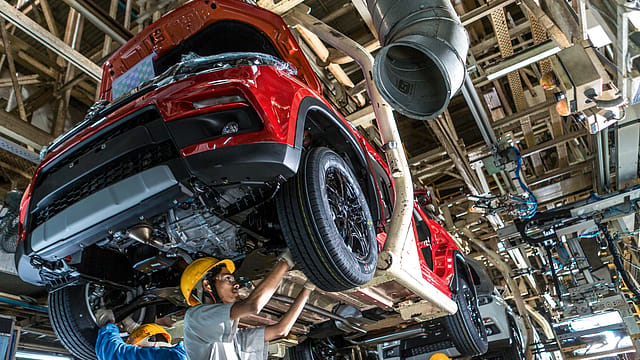Knock, knock. Who’s there? Recession
ADVERTISEMENT

The R-word is rearing its ugly head again. As it does from time to time. And when it does, it becomes a talking point. The current economic climate—not just globally but at home—is a breeding ground for conjecture (are we in recession?) and debate (but how do we define it?).
The idea of recession, as first defined by Julius Shiskin, a former head of economic research and analysis, U.S. Census Bureau, in an article in The New York Times (1974)—as an economy reporting two quarters of negative growth—continues to have many takers, including in India. But it is not a universally accepted characterisation. The National Bureau of Economic Research, a U.S. not-forprofit think tank, defines an economic recession as “a significant decline in economic activity spread across the economy, lasting more than a few months, normally visible in real GDP [gross domestic product], real income, employment, industrial production, and wholesale-retail sales.’’
Whether a nation is in recession, therefore, boils down to how the condition is defined. Minister of finance and corporate affairs Nirmala Sitharaman in her short-duration discussion in the Rajya Sabha on November 27, 2019, said: “Growth may have come down… but it is not a recession yet, and won’t be a recession ever.’’
Sitharaman isn’t wrong in a larger context—if her statement is mapped against Shiskin’s checklist. But, as has been pointed out by economists over the last few decades, there is an inherent flaw in a strict adherence to any one definition. The 2001 recession in the U.S., for instance, did not fall within the accepted parameters of Shiskin’s definition: Instead of two consecutive quarters of declining GDP growth, it was preceded by two quarters of alternating decline and weak growth. But a recession it was. Similarly, a detailed analysis of the JulySeptember quarter (Q2) of FY20 numbers shows a “significant decline” in some sectors, while other sub-components of the GDP have already slipped into Shiskin’s recession. Real GDP growth in Q2FY20, at 4.5% (from 7% in the same period last year), is the worst in the last 26 quarters, while a nominal GDP growth of 6.1% is the lowest in the new GDP series (the methodology was changed, as was the base year, from FY05 to FY12).
The sub-components which faced the biggest slide in output were coal, which contracted by 10.3%, crude oil by 5.1%, natural gas by 2.6%, and mining by 1.2%. Consumer-facing industries too saw volumes decline with sales of consumer durables falling to a negative 7.2%, two-wheelers -20%, and car sales -36.8%. Even the manufacturing sector is already in Shiskin’s recession. It grew by a negative 0.2% in the six months, compared to 9.2% in the first half of FY19. As Amir Ullah Khan, an economist and professor at NALSAR University of Law, Hyderabad, explains: “It is not that there is just a slowing down in growth rates, but [also] a reduction of GDP in real terms.’’
It is telling, also, that the capital goods sector, an integral part of industry and a broad indicator of India Inc.’s desire for capacity expansion, has registered negative growth in the March quarter of FY19 (-7.4%), and in the June and September quarters of FY20 (-3.5% and -16.4%).
Similarly, tractor sales, a barometer of the health of agriculture, were down by 6.3%, 14.4%, and 11.5% too. It follows that agricultural growth slipped from 5% in the first half of FY19 to 2.1% in the corresponding period this fiscal.
As a result, despite the devaluation of the rupee—it has been hovering around `69 to ₹72 a dollar for months now—there has been no significant increase in exports. They have, in fact, slipped from 12.7% in Q2FY19 to negative 0.4% in Q2FY20. Imports, which registered a negative 1.6% growth in the past six months, are now in full-blown recession.
The automobile industry is facing a similar struggle. Car sales have been plummeting since September 2018, the last three quarters have shown a contraction of 4.6%, 23.3%, and 36.8%, respectively. Two-wheelers, too, report no joy (-8.9%, -11.6%, and -20.4%).
With the slowdown this deep and widespread, there is little hope for a V-shaped or rapid rebound, say analysts Fortune India spoke to. It will be a long-drawn process because the government’s fiscal space to support economic activity is limited, they say, pointing to the corporate tax rate cut and the shortfall in the goods and services tax mop-up in particular. Nikhil Gupta, research analyst at broking firm Motilal Oswal, says GDP growth in Q3FY20 could weaken to 4% because the leading indicators in October FY20— a festive month—were the worst in the current cycle. “So we are cutting our growth forecast from 5.7% to 4.5% in FY20.” International Monetary Fund (IMF) chief economist Gita Gopinath too told news agency PTI that “the extent of the slowdown of the Indian economy has surprised many, including us here at the IMF”.
But industry is holding out hope—both for the short term and for a better bigger picture. Dilip Chenoy, secretary general of FICCI (Federation of Indian Chambers of Commerce and Industry), believes that the “recovery should happen in the next two quarters”. He attributes the slowdown to the transitions underway in the economy—the move from socialism to market-orientation, from an informal to a formalised structure, ensuring far greater transparency and accountability in the financial sector, and better governance structure across all industries. “All these new rules and procedures have disrupted the way businesses were conducted earlier, but for the new breed of businessmen, it will be far easier and simpler to do business in the country,’’ says Chenoy.
This story was originally published in the January 2020 edition of the magazine.